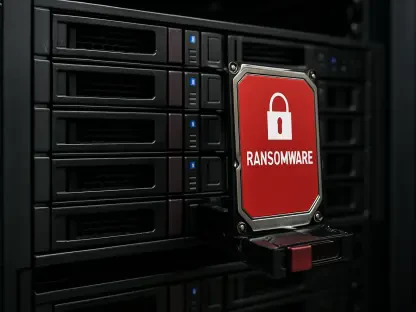In today’s digital age, businesses are increasingly relying on Software as a Service (SaaS) applications to enhance productivity and streamline operations. While these cloud-based tools such as Slack, Google Workspace apps, Jira, and Zendesk are invaluable, they come with their own set of security challenges. Given the complexity and risks associated with these platforms, experts emphasize implementing human firewall strategies to protect data integrity and prevent breaches.
The Proliferation of SaaS Solutions
Increasing Usage of SaaS
A recent survey reveals that 70% of organizations use over 50 different SaaS solutions, with nearly one-third deploying 200 or more such applications. This trend demonstrates the critical role SaaS tools play across various business functions, from project management to customer support. Their ease of deployment and ability to foster collaboration make them indispensable, but the rapid growth also introduces unprecedented security risks. Businesses are adopting these tools at a breakneck pace, each providing specific functionalities to optimize workflow and communications. From small startups to large enterprises, the allure of SaaS is hard to ignore due to its scalability and cost-effectiveness. Yet, this very proliferation becomes a double-edged sword when it comes to data security.
Organizations utilizing a wide array of SaaS tools often find themselves in a complex web of interdependent platforms, each with its own set of permissions, access controls, and data storage mechanisms. This complexity can be challenging to manage, especially without a centralized security framework. The need for integration is paramount, but so is the challenge of maintaining a secure environment amidst such a diverse digital ecosystem. Each additional SaaS solution potentially widens the organization’s attack surface, making it more vulnerable to cyber threats that can exploit any weak links within this network.
Underlying Risks
With the surge in cloud-based tools, the frequency of data security incidents has also risen. According to Verizon’s 2024 Data Breach Investigations Report, 68% of data breaches involve human errors or social engineering attacks. These statistics underline the urgency for robust security measures tailored to the unique vulnerabilities of SaaS environments. Cloud-based systems, while streamlined and efficient, often lack the rigid security structures found in on-premises solutions, making them susceptible to a variety of cyber threats. The reliance on human interaction for many SaaS operations further amplifies these risks, as employees can inadvertently become the weakest link in the security chain.
The inherent design of SaaS applications usually prioritizes ease of use and broad accessibility, occasionally at the expense of robust security features. This ease of access opens up pathways for human error, whether through accidental data sharing, weak passwords, or falling prey to phishing attacks. Social engineering attacks, in particular, exploit these human vulnerabilities, tricking users into revealing sensitive information or granting unauthorized access. Therefore, it is essential to recognize that humans play a significant role in the security posture of SaaS platforms, making the case for human firewall strategies all the more compelling.
The Human Firewall: A Crucial Defense Mechanism
Combining Education with Technology
One of the foremost strategies to tackle these risks is the implementation of a human firewall. This approach involves meticulous employee training paired with dynamic security alerts. By educating employees on recognizing and reacting to potential threats, the workforce itself becomes a formidable line of defense against cyberattacks. A well-informed employee can serve as a critical barrier against phishing attempts, malware, and other forms of cyber exploitation that rely heavily on manipulating human behavior. Regular training sessions and workshops should be conducted to ensure employees are up-to-date with the latest threat intelligence and best practices.
To enhance this strategy further, combining educational efforts with advanced technological solutions can create a more resilient defense layer. Security tools that offer real-time notifications and alerts for suspicious activities can complement the human firewall by providing immediate feedback to employees. This symbiotic relationship between technology and human vigilance ensures that potential breaches are quickly identified and mitigated, thereby reducing the likelihood of a successful attack. Effective deployment of this strategy necessitates a continuous cycle of education and technological updates, aligning with the evolving cyber threat landscape.
Continuous Learning and Adaptation
Training initiatives can’t be one-off; they need to be ongoing and adaptive. Cybersecurity threats evolve, and so must the training modules. Regular updates and refreshers ensure that employees remain vigilant and well-versed in the latest security protocols. The integration of this knowledge into day-to-day activities helps in preempting potential breaches. It requires organizational commitment to maintain a culture of continuous learning, where employees are not only trained but also encouraged to engage with and challenge existing security norms.
An effective training program should incorporate simulated phishing attacks, interactive modules, and real-world case studies to provide practical, hands-on experience. Feedback from these training sessions can help identify weak points in the organization’s security practices, enabling targeted improvements. Furthermore, fostering an environment where employees feel comfortable reporting suspicious activities without fear of reprimand can greatly enhance internal security awareness and responsiveness. This ongoing learning process is pivotal in building a human firewall that can adapt to new threats and ensure long-term security resilience.
Real-Time Security Tools and Policies
Importance of Real-Time Alerts
In addition to training, adopting security tools that provide real-time alerts can significantly mitigate risks. These tools flag risky behaviors and notify employees instantly, allowing for immediate corrective actions. The real-time nature of these alerts ensures that threats are neutralized before they escalate into serious breaches. When integrated seamlessly into daily workflows, these tools not only enhance security but also help in embedding security-conscious behaviors among employees. Real-time alerts can cover a multitude of scenarios, from unauthorized data access attempts to unusual login locations, providing a comprehensive monitoring solution.
The benefits of real-time alerts extend beyond immediate threat neutralization. They also offer valuable insights into the types of risks an organization faces, allowing for data-driven security improvements. By analyzing alert patterns, security teams can identify common vulnerabilities and devise targeted strategies to address them. This proactive approach ensures that security measures evolve in tandem with emerging threats, maintaining a robust defense posture. Moreover, these tools can often be configured to align with organizational policies, ensuring that security protocols are adhered to without disrupting daily operations.
Establishing Clear Policies
Clear, enforced policies play a pivotal role in a human firewall strategy. Organizations must set stringent guidelines for downloading and using SaaS applications. Ideally, each app should receive prior approval from the security team, ensuring that only vetted tools enter the work environment. This disciplined approach reduces exposures and fosters a secure collaborative space. Policies should encompass all aspects of SaaS usage, including access controls, data sharing permissions, and guidelines for safe usage. By establishing a comprehensive framework, organizations can significantly reduce the likelihood of unauthorized access or data breaches.
Policy enforcement should be supplemented with regular audits and compliance checks to ensure adherence. Non-compliance should be addressed promptly, with corrective actions communicated clearly to prevent recurrence. Additionally, fostering a culture of accountability where employees understand the importance of these policies can enhance compliance rates. Utilizing automation tools to enforce policies can also alleviate the administrative burden, ensuring consistent application across the organization. By integrating these policies into the organizational fabric, businesses can create a secure environment that supports the effective use of SaaS applications without compromising data integrity.
Challenges in Collaborative SaaS Environments
Risks in Collaboration
While collaborative tools like Slack and Google Workspace are essential, they also present high-risk environments for data security. External sharing, a common feature in these tools, can create entry points for unauthorized access. Thus, policies governing the sharing of access with external partners or customers become crucial. Organizations must strike a balance between enabling seamless collaboration and maintaining stringent security protocols. This involves setting clear guidelines on what information can be shared externally and under what circumstances, along with who is authorized to make such decisions.
Managing the flow of information in a collaborative environment requires constant vigilance and monitoring. Access logs should be meticulously maintained and reviewed to identify any unusual activities. Multi-factor authentication (MFA) should be enforced to add an extra layer of security for users accessing these platforms. Furthermore, educating employees on the potential risks and best practices for secure collaboration can help mitigate threats that arise from human error. By addressing these challenges head-on, businesses can leverage collaborative tools effectively while maintaining a robust security posture.
Managing Access and Permissions
Effective management of access permissions is essential to maintain security. This involves regular audits and monitoring to ensure that only authorized personnel have access to sensitive data. By keeping a tight leash on who can access what, businesses can significantly reduce potential vulnerabilities. Access control mechanisms should be robust, incorporating role-based access controls (RBAC) to limit data exposure based on user roles. Regularly updating and reviewing these permissions can help in identifying and rectifying any anomalies, ensuring that access is granted only to those who genuinely need it.
Audits should also include checks for compliance with established security policies. Automated tools can simplify this process by providing real-time reports on access activities and flagging any deviations from the norm. Implementing least privilege principles ensures that employees have the minimum access necessary to perform their duties, reducing the risk of data leaks or unauthorized data manipulation. Effective access management not only strengthens the overall security posture but also fosters a culture of accountability, where employees are aware of the importance of safeguarding sensitive information.
Scaling Data Security Efforts
Proactive Security Measures
The modern cybersecurity landscape demands a proactive stance. Instead of reacting to incidents after they occur, businesses must employ constant monitoring and incident response plans. This proactive approach boosts an organization’s resilience against potential threats. Implementing advanced threat detection systems that leverage artificial intelligence (AI) and machine learning (ML) can help identify anomalies and potential security breaches before they cause significant damage. These systems can continuously analyze vast amounts of data, providing real-time insights into the organization’s security posture.
Incident response plans should be comprehensive, detailing the steps to be taken in the event of a security breach. Regular drills and simulations can ensure that all employees are familiar with these procedures, enabling swift and coordinated responses. By establishing a proactive security framework, organizations can minimize the impact of cyberattacks and ensure business continuity. This approach not only mitigates risks but also reinforces the organization’s commitment to maintaining high security standards, instilling confidence among stakeholders.
The Role of Security Awareness
In today’s digital era, businesses are increasingly turning to Software as a Service (SaaS) applications to boost productivity and streamline their operations. These cloud-based tools, which include popular platforms like Slack, Google Workspace apps, Jira, and Zendesk, have become essential in the modern business landscape. Despite their invaluable benefits, these SaaS applications present their own set of security challenges. Because of the intricate nature and potential risks associated with these platforms, experts strongly advocate for the implementation of human firewall strategies. A human firewall involves educating and training employees to recognize potential security threats and understand best practices for safeguarding sensitive data. By focusing on human behavior and awareness, companies can significantly fortify their defenses against data breaches and maintain data integrity. These measures ensure that employees become the first line of defense, reducing vulnerabilities and enhancing overall security. Therefore, investing in human firewalls is crucial for any business utilizing SaaS applications in today’s digital environment.









